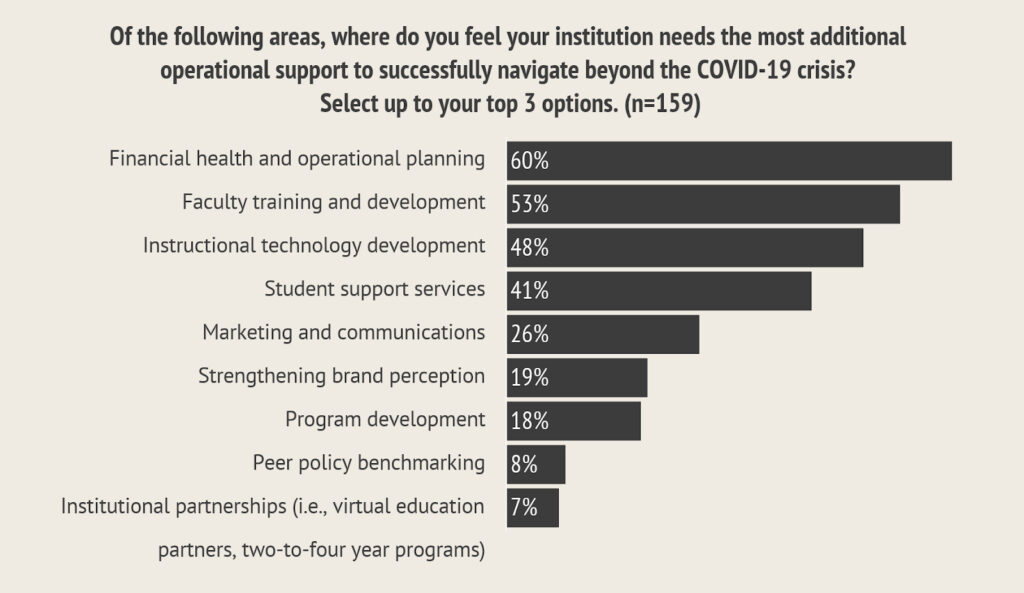Throughout the COVID-19 pandemic, the fundraising industry faced a year of unprecedented times and constant changes. The higher education sector saw a dramatic shift due to COVID-19 with the transition to online learning and virtual communication.
The Impact of COVID-19 on Higher Education Institutions

As the COVID-19 pandemic swept across the globe, higher education institutions were forced to deal with numerous challenges. Moving students off-campus and adopting a virtual platform for online classes quickly became top priorities.
-
Loss of Income Due to Virtual Learning
With most college students being vacated from their dorms and on-campus housing arrangements after their 2020 spring break, institutions faced an income loss. Entering into the fall semester, few colleges chose to try on-campus living. Many stuck to closed campuses with virtual learning.
A consequence of students living and learning remotely means no money is being spent on campus housing or meal plans. On top of these losses, colleges saw a drop off from income being raised during extracurricular activities. College sporting events, campus stores, and book sales took massive losses during the COVID-19 pandemic.
-
Impact of COVID-19 on Alumni Relations
Another major area of income for higher education institutions comes from alumni donations. Depending on the school’s traditions, much of this fundraising is done through in-person events. This includes class reunions, alumni nights for athletics, and networking events.
Since the COVID-19 pandemic led to restrictions on in-person gatherings and events, alumni fundraising faced a new challenge to generate income. Just like virtual courses, higher education institutions have adapted their fundraising strategies for the digital world.
The Short-Term Outlook for Higher Education Fundraising
Flexibility is crucial when creating short-term solutions for the challenges higher education is facing during the pandemic. Income losses will continue until the end of COVID-19 from the lack of students on campus. Colleges and universities must adapt to make up the money elsewhere.
Development officers can benefit from donor engagement strategies. This means working with different departments in the institution to cultivate new donor relationships. It is also vital to maintain connections with established gifters.
-
Shifting Higher Education Fundraising Priorities During COVID-19
In the wake of the pandemic, higher education fundraising has shifted toward a less isolated, more progressive agenda. Institutions must adopt elements of a solidarity approach to stay relevant with their donors.
Rather than focusing on the individual benefits of donations, COVID-19 has created a movement centered around giving for the collective good. Successful fundraising strategies will prioritize a social agenda within universities.
On top of these changing ideals, the structure of higher education fundraising is evolving. Without in-person events, the main form of communication with donors is through virtual marketing. Institutions are relying on digital platforms to share their message and cultivate donors.
Instead of connecting donors, particularly alumni, with an institution’s location or experiences, digital marketing highlights the mission and brand. This shift is changing the priorities of higher education fundraising as it creates a need for a universally relatable mission.
Long-Term Predictions for Higher Education Fundraising

Institutions had to adapt quickly once COVID-19 hit, with a focus on short-term solutions to make it through the upheaval. However, there will also be long-term changes as a result of the pandemic.
Virtual fundraising strategies are here to stay. Although in-person events will slowly begin to resume as the pandemic ends, digital efforts will be more important than ever to stay relevant while fundraising.
Higher education will need to strike a balance between fundamental needs and donor interests. The COVID-19 pandemic has shown the struggles institutions are facing during fundraising as they continue to adapt to younger donors and changing social backdrops.
While universities will always need to fulfill their own essential fundraising goals, it will be crucial to account for the donor’s wants in the post-pandemic world. This stems from the surge of global outreach focused on the greater good during the COVID-19 crisis. Now, donors are comfortable with having a say in an institution’s mission, and fundraising strategies must adapt.
A push for focus on helping ease the burden of higher education on students rather than on the institution itself is a trend that will most likely stick after the pandemic. COVID-19 opened eyes to the financial burden placed upon students, and donors have the opportunity to use their gifts to help.
In keeping with the idea of solidarity instead of philanthropy, higher education fundraising goals will balance between institutional needs and easing student debt burden. This includes a push for scholarship funding, health and wellness initiatives, and enhanced student services.
Overall, universities will need to continue the work started during the COVID-19 pandemic to engage new donors and strengthen existing relationships. Athletics may be sidelined, as well as major capital projects, to make way for tackling donor wishes to better support students.
Serving the Higher Education Community During Covid-19
Throughout the pandemic, higher education institutions have been expected to adapt and persevere despite the tumultuous times. Virtual learning has placed a strain on students and staff as they continue to navigate uncharted terrority. Universities are beginning to see traditions questioned as new strategies emerge.
The main focus of universities during COVID-19 has been placed on providing quality education in unprecedented circumstances. Campus life halted at the beginning of the pandemic, which forced institutions to shift priorities while serving the community.
Instead of kick starting capital projects like campus building upgrades or major renovations, higher education has adapted to meet the needs of their communities. This includes aiding their population with health and wellness programs, accessible COVID-19 testing, and virtual learning programs.
Fundraising Strategies During Pandemic Recovery
Focus on digital outreach across multiple platforms like Instagram and email campaigns. Virtual marketing allows higher education fundraising to stay relevant while reaching new audiences. Shift your messaging to share how your university is supporting the community during this time.
Recovery may be a long road as the pandemic fades, so flexibility will continue to remain crucial for successful fundraising. As students slowly begin to return to campus life, consistent branding and communication will help keep your donors engaged with your mission.
